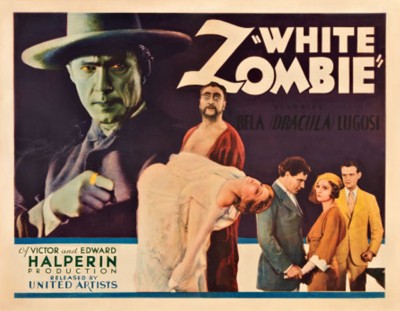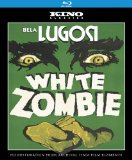| Reviews & Columns |
|
Reviews DVD TV on DVD Blu-ray 4K UHD International DVDs In Theaters Reviews by Studio Video Games Features Collector Series DVDs Easter Egg Database Interviews DVD Talk Radio Feature Articles Columns Anime Talk DVD Savant Horror DVDs The M.O.D. Squad Art House HD Talk Silent DVD
|
DVD Talk Forum |
|
|
| Resources |
|
DVD Price Search Customer Service #'s RCE Info Links |
|
Columns
|
|
|
White Zombie (Kino Classics' Remastered Edition)
White Zombie was not a great success during its initial release, but made a fortune in its frequent reissues, sometimes accompanying live spook shows. It turned up on television early on, and has been in the public domain for years. That's resulted in some genuinely awful video transfers from labels specializing in PD titles. The Roan Group had what was considered the best video master for the past 20 years or so.
Now White Zombie comes to Blu-ray courtesy Holland Releasing via distributor Kino Lorber. One of the strangest high-def releases to date, it features two different video transfers of the 67-minute feature, a "digitally restored version from a 35mm fine grain master" and a "raw, unenhanced film transfer."
No doubt the unanimous reaction to these was not something Holland or Kino expected. The "raw" version, despite its myriad imperfections, improves upon all earlier home video editions and is infinitely superior to the so-called "digitally restored version," a travesty that's completely unwatchable and never should have been released at all.
In Haiti, Madeline Short (Madge Bellamy) and her fiancé, Neil Parker (John Harron), encounter strange pasty-faced, bug-eyed sugar plantation workers that their nervous coachman identifies as undead zombies, transformed into slaves by jutting unibrowed voodoo master "Murder" Legendre (Lugosi). The young couple arrives at the home of wealthy plantation owner Charles Beaumont (Robert Frazer), who makes one last plea to Madeline to marry him instead of Neil, but she refuses.
In desperation Charles turns to the gleefully sadistic Legendre, who happily poisons Madeline on her wedding day. Believed dead, she's buried but immediately secretly exhumed by Legendre and Charles and taken to the former's cliffside castle where she becomes a rare living zombie. But, in an interesting twist, Charles soon realizes he cannot love the inexpressive, glassy-eyed Madeline and falls into a deep, alcohol-fueled depression.
Neil, meanwhile, has a ghostly vision of Madeline and discovers her grave robbed. Eventually he joins forces with the Van Helsing-esque Dr. Bruner (Joseph Cawthorn) to rescue her.
As he would in countless cheap films into the 1950s, Lugosi's presence lends White Zombie an air of grandeur and the whole film revolves around his engaging if theatrical gestures and poses, including tight close-ups of his eyes staring directly into the camera (similar shots appear in Dracula) and an oft-imitated gesture (seen in the original poster) meant to demonstrate Legendre's mental dominance over his zombie slaves, in which Lugosi seems to be having a tug-of-war contest with himself. (In Tim Burton's Ed Wood, Lugosi and Wood watch White Zombie on TV, and Wood tries this gesture himself.)
The Halperin Brothers, director Victor Hugo and producer Edward, really lucked out here, securing Lugosi's services for just $5,000 but possibly as little as $500 (sources vary) and use of Universal's stages and backlot for, reportedly, another $11,000. Sets from Dracula, Frankenstein, and the 1923 version of The Hunchback of Notre Dame turn up, and Universal's make-up whiz, Jack Pierce, created Lugosi's strange appearance. Other scenes were shot in nearby Bronson Canyon, including the effective scenes of the zombies staggering about a tombstone-littered hillside.
The low budget probably drove the decision to keep dialogue to a minimum, confining the bulk of the exposition to a couple of studio interiors. But the emphasis on the visual helps the film enormously, and director Edward Halperin and cinematographer Arthur Martinelli consistently shoot from interesting angles, often looking at characters through fences and other objects.
Other than Lugosi, the rest of the film casts down-on-their-luck types. Madge Bellamy was a silent star with that era's typical saucer-eyed virginal beauty in the Lillian and Dorothy Gish mold, but whose pronounced lisp and limited acting chops shut the door on her days as a leading lady at the dawn of sound.* Dr. Bruner was probably written for Edward Van Sloan, who played Van Helsing in Dracula and similar roles in Frankenstein and The Mummy, but for whatever reason Joseph Cawthorn was cast instead. A Vaudevillian famous as a Dutch comic, in many ways he's closer to Bram Stoker's literary Van Helsing, but his comical, German-accented delivery does give one pause.
Video & Audio
First, the good news: The "raw, unenhanced film transfer" markedly improves on The Roan Group release, the best of the earlier home video versions of White Zombie. It's far from perfect. The transfer sources very grainy 35mm elements, but far more detail is visible than the Roan version, and contrast and black levels are strong. There are scratches galore, sound dropouts, and splice-driven jump cuts, and inferior 16mm elements have replaced two scenes totaling about 90 seconds of footage. But at least it looks like 35mm film. For an independent movie made 80 years ago by a long-defunct production company, White Zombie was never going to match the splendiferous Blu-rays of Universal's Monsters set, but that can't reasonably be expected. Of this version, I was quite pleased and even impressed, considering. The 2.0 mono audio is okay on both versions, and the Picture Rating for the "raw" version gets three stars (***).
The "digitally restored version" is anything but, instead exemplifying the pitfalls of relying on unmonitored, imperfect computer programs to clean up old movies. It's impossible to say whether the people at Holland Releasing were simply incredibly inept or depressingly uncaring with their slathering of White Zombie. The results have all the subtlety of Cecilia Jimenez, the 80-year-old amateur painter whose own "restoration" efforts ruined irreplaceable 19th century frescos and became a worldwide laughingstock.
Didn't anyone there bother to compare the two versions? In the "restored" version, all detail is wiped away clean. Matte paintings of Legendre's castle, which look like paintings, are reduced to schematic line drawings. Madeline's wedding gown and the two white horses Charles and Dr. Bruner ride burn white-hot like supernovas. It looks worse than most 99-cent DVDs of the film. This version gets zero stars (Zero *).
Extra Features
Supplements include a 1932 "Intimate Interview," a one-reel short with Lugosi that's worthwhile, and a wonderfully lurid 1951 reissue trailer that'd certainly have me lining up at the next show. Film historian Frank Thompson provides an audio commentary, and a pretty decent still gallery rounds out the extra features.
Parting Thoughts
Whatever you do, DON'T watch the "restored" version of White Zombie. However, the accompanying "raw version" isn't bad. It and the good extra features included with this disc more than compensate for one of the most misguided, woebegone video transfers in recent memory. Recommended.
* Sergei Hasenecz adds, "Sometime in either 1989 or 1990, I saw a screening of The Iron Horse at the Autry Museum with 90-year-old Madge Bellamy in attendance. (The Autry opened in 1988, Bellamy died in 1990). There was live music by Robert Israel, and the sequence introducing George O'Brien was (no exaggeration) breathtaking. Best of all, though, was Bellamy off-screen. Before the movie started, she was introduced from where she sat in the audience and asked if she might say something. She rose graciously, smiling and acknowledging the applause. She then spoke, and this was its entirety: 'As Marc Anthony said when he entered Cleopatra's tent, "I did not come to speak." Roll the film.' And still smiling, she sat down."
Stuart Galbraith IV is a Kyoto-based film historian whose work includes film history books, DVD and Blu-ray audio commentaries and special features. Visit Stuart's Cine Blogarama here.
|
| Popular Reviews |
| Sponsored Links |
|
|
| Sponsored Links |
|
|
| Release List | Reviews | Shop | Newsletter | Forum | DVD Giveaways | Blu-Ray | Advertise |
|
Copyright 2024 DVDTalk.com All Rights Reserved. Legal Info, Privacy Policy, Terms of Use,
Manage Preferences,
Your Privacy Choices | |||||||














